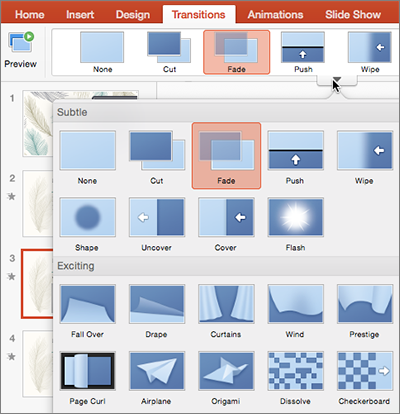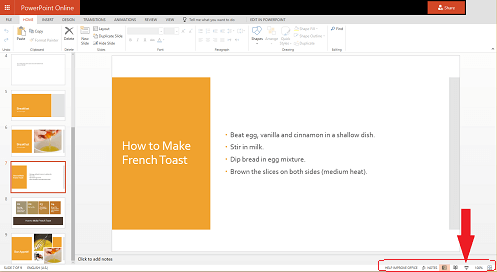A slide transition is the visual effect that occurs when you move from one slide to the next during a presentation. You can control the speed, add sound, and customize the look of transition effects.
Add a transition to a slide
-
Select the slide you want to add a transition to.
-
Select the Transitions tab and choose a transition. Select a transition to see a preview.
-
Select Effect Options to choose the direction and nature of the transition.
-
Select Preview to see what the transition looks like.
Select Apply To All to add the transition to the entire presentation.
Remove a transition
A transition determines how a slide enters, and how the previous slide exits. So if (for example) you didn't want a transition effect between slides 2 and 3, you would remove the transition from slide 3.
-
Select the slide that has the transition you want to remove.
-
On the Transitions tab, in the Transitions gallery, select None.
If you want to remove all transitions from the presentation, after you select None, select Apply to All.
Change a transition
Only one transition effect can be applied to a slide at a time. So if a slide already has a transition effect applied to it, you can change to a different effect by going to the Transitions tab and simply selecting the effect you prefer.
If you want to change an existing effect by modifying the timing or direction of it, you can that by using the options on the Transitions tab of the ribbon, at the far end:
-
Select the slide that has the transition you want to modify.
-
On the Transitions tab, select Effect Options, then choose an option from the menu that appears.
-
In the Timing group on the Transitions tab, you can change the duration of the effect. You can also specify whether the effect takes place after a mouse click or after a certain amount of time passes. There are also options for adding a sound to the transition effect or applying the transition to all slides in the slide show.
See Also
Set the timing and speed of a transition
Video: Add a sound effect to a transition
Use the Morph transition in PowerPoint (only in Microsoft 365 or PowerPoint 2021/2019)
Add a transition to a slide
-
In the thumbnail pane, click the slide that you want to apply a transition to. (The transition effect determines how a slide enters, and how the one before it exits.) In the example below, applying a Fade transition to slide 3 means that slide 2 fades out, and slide 3 fades in.

-
On the Transitions tab, find the effect that you want in the Transition gallery. Click the down arrow to see the entire gallery. Click the effect that you want for that slide and to see a preview.
-
Click Transitions > Effect Options to customize the effect—for example, what direction the slide enters from.
-
Enter a time at Duration to set how fast the transition goes. Set the number higher to make the transition go slower.
-
Click Preview to see what the transition looks like with all the settings.

Tips:
-
If you want all slides in the presentation to transition the same way, select Apply To All on the ribbon.
-

-
Remove a transition
A transition determines how a slide enters, and how the previous slide exits. So if (for example) you didn't want a transition effect between slides 2 and 3, you would remove the transition from slide 3.
-
Select the slide with the transition you want to remove.
-
On the Transitions tab, in the Transitions gallery, select None.

If you want to remove the transitions from all slides, select Apply to All on the ribbon after selecting None.
Tips:
-
You can tell which slides have a transition effect applied by looking for the transition icon in the thumbnail pane:
-

Change a transition
Only one transition effect can be applied to a slide at a time. So if a slide already has a transition effect applied to it, you can change to a different effect by going to the Transitions tab and simply selecting the effect you prefer.
If you want to change an existing effect by modifying the timing or direction of it, you can that by using the options on the Transitions tab of the ribbon, at the far end:
-
Select the slide that has the transition you want to modify.
-
On the Transitions tab, select Effect Options, then choose an option from the menu that appears.
-
In the Timing group on the Transitions tab, you can change the duration of the effect. You can also specify whether the effect takes place after a mouse click or after a certain amount of time passes. There are also options for adding a sound to the transition effect or applying the transition to all slides in the slide show.
See Also
Add or change a slide transition
-
In the thumbnail pane, select the slide where you want to apply or change a transition. The transition will begin on the preceding slide and conclude on the slide you've selected.

-
On the Transitions tab, find the effect that you want in the Transition gallery.
-
Click Effect Options to specify how the transition occurs.
-
Optional:
-
To set how fast the transition goes, enter a time in the Duration box on the ribbon. Set the number higher to make the transition go slower. For more about transition timing, see Set the speed and timing of transitions.
-
If you want all slides in the presentation to transition the same way, click Apply To All.
-
-
To see the transition in action, select the slide that begins the transition , and then click the Slide Show icon
 at the lower-right corner of your browser window.
at the lower-right corner of your browser window.
(This button starts the slide show at the currently selected slide, rather than beginning the slide show from the start of the presentation.)
Remove a transition
A transition determines how a slide enters, and how the previous slide exits. So if (for example) you didn't want a transition effect between slides 2 and 3, you would remove the transition from slide 3.
-
Select the slide that you want to have no transition. Then, on the Transitions tab, in the Transitions gallery, select None.

In our example, if slide 3 has no transition, it appears instantly as slide 2 disappears.
If you want to remove the transitions from all slides, select Apply to All on the ribbon after selecting None.
Change a transition
Only one transition effect can be applied to a slide at a time. So if a slide already has a transition effect applied to it, you can change to a different effect by going to the Transitions tab and simply selecting the effect you prefer.
If you want to change an existing effect by modifying the timing or direction of it, you can that by using the options on the Transitions tab of the ribbon, at the far end:
-
Select the slide that has the transition you want to modify.
-
On the Transitions tab, select Options, then choose an option from the menu that appears.
-
You can also change the duration of the effect. The timing is measured in seconds.
Add an animation effect on a slide
If you're looking for information about how to add animation to text elements or objects within one slide, see Animate text or objects.